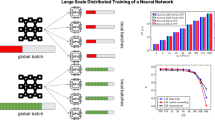Abstract
Deep learning researchers are increasingly using Jupyter notebooks to implement interactive, reproducible workflows with embedded visualization, steering and documentation. Such solutions are typically deployed on small-scale (e.g. single server) computing systems. However, as the sizes and complexities of datasets and associated neural network models increase, high-performance distributed systems become important for training and evaluating models in a feasible amount of time. In this paper we describe our vision for Jupyter notebook solutions to deploy deep learning workloads onto high-performance computing systems. We demonstrate the effectiveness of notebooks for distributed training and hyper-parameter optimization of deep neural networks with efficient, scalable backends.
Access this chapter
Tax calculation will be finalised at checkout
Purchases are for personal use only
Similar content being viewed by others
References
Bhimji, W., Farrell, S.A., Kurth, T., Paganini, M., Racah, E., Prabhat: Deep neural networks for physics analysis on low-level whole-detector data at the LHC. arXiv preprint arXiv:1711.03573 (2017)
Chollet, F.: keras (2015). https://github.com/fchollet/keras
Crow, J.F.: Advantages of sexual reproduction. Genesis 15(3), 205–213 (1994)
Dask Development Team: Dask: Library for dynamic task scheduling (2016). http://dask.pydata.org
Jaderberg, M., et al.: Population based training of neural networks. CoRR abs/1711.09846 (2017). http://arxiv.org/abs/1711.09846
Kluyver, T., et al.: Jupyter notebooks – a publishing format for reproducible computational workfows. In: Loizides, F., Schmidt, B. (eds.) Positioning and Power in Academic Publishing: Players, Agents and Agendas. pp. 87 – 90. IOS Press (2016)
LeCun, Y., Bengio, Y., Hinton, G.: Deep learning. Nature 521(7553), 436 (2015)
Mendygral, P., Hill, N., Kandalla, K., Davis, M., Balma, J., Schongens, M.: High performance scalable deep learning with the cray programming environments deep learning plugin. In: Proceedings of CUG (2018)
Rocklin, M.: Dask: parallel computation with blocked algorithms and task scheduling. In: Huff, K., Bergstra, J. (eds.) Proceedings of the 14th Python in Science Conference, pp. 130–136 (2015)
Sergeev, A., Balso, M.D.: Horovod: fast and easy distributed deep learning in TensorFlow. arXiv preprint arXiv:1802.05799 (2018)
Acknowledgements
This research used resources of the National Energy Research Scientific Computing Center, a DOE Office of Science User Facility supported by the Office of Science of the U.S. Department of Energy under Contract No. DE-AC02-05CH11231. This work was in part supported by the NERSC Big Data Center; we acknowledge Cray for their funding support.
Author information
Authors and Affiliations
Corresponding author
Editor information
Editors and Affiliations
Rights and permissions
Copyright information
© 2018 Springer Nature Switzerland AG
About this paper
Cite this paper
Farrell, S. et al. (2018). Interactive Distributed Deep Learning with Jupyter Notebooks. In: Yokota, R., Weiland, M., Shalf, J., Alam, S. (eds) High Performance Computing. ISC High Performance 2018. Lecture Notes in Computer Science(), vol 11203. Springer, Cham. https://doi.org/10.1007/978-3-030-02465-9_49
Download citation
DOI: https://doi.org/10.1007/978-3-030-02465-9_49
Published:
Publisher Name: Springer, Cham
Print ISBN: 978-3-030-02464-2
Online ISBN: 978-3-030-02465-9
eBook Packages: Computer ScienceComputer Science (R0)




